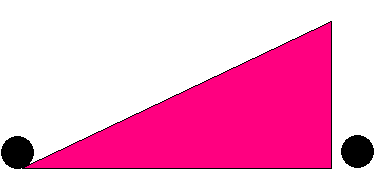
The Ramp (animation)
Key Terms
block and tackle
hydraulic press
gears
ramp
screw
wedge
The last section dealt exclusively with one machine - the lever. We will introduce several other simple machines here, most of which were known and used by ancient civilizations. As was the case with the lever, these simple machines tend to make a hard job easy by trading a big force applied over a short distance for a smaller force applied over a longer distance.
A ramp is so basic that it requires no explanation. Need to transport a heavy barrel on a truck? Roll it up a ramp and the job seems much easier.

The Ramp (animation)
Referring to the image above where two identical weights are lifted to the same height, in both cases the same amount of work is done (if frictionless), but the ramp makes it much easier. If the object is on wheels, all the better! That produces much less friction than sliding it up the ramp.
Suppose the weight is 100 pounds and the vertical displacement is 3 feet. Also suppose the length of the ramp is 6 feet. If one were to lift the weight straight up, it would take 100 * 3 ft pounds of work. However, rolling the same weight up the ramp (over a distance of 6 feet) would only require 50 pounds of force to do the same amount of work. Numerically, you can see a mechanical advantage of 2 (assuming no friction).
People who hike in mountains know that it is much easier to walk up gentle inclines than to scale straight up the mountain side. Common sense will tell you that the gentler the slope, the easier it gets, but the effort must be applied over a longer distance.
Applications:
The Ancient Egyptians most likely used temporary dirt ramps to lift the heavy stones in the construction of the pyramids. Conveyor belts are used to lift objects gradually to higher locations, specifically, farmers moving bales of hay to a barn or roofers delivering bundles of shingles to a job. A few years ago I built a garage and constructed a ramp to move heavy 4'x8' plywood sheets to the roof. You might want to drive your car up a ramp to change the oil. Can you think of some other places ramps are used?
The wedge is nothing more than a moving ramp, but it is still considered in a class by itself. A camper can split some firewood with a wedge by trading a smaller force (acting over a greater distance) to provide a much larger force (acting over a smaller distance).
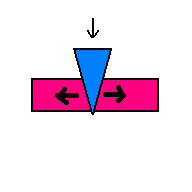
The Wedge (animation)
This principle is also applied in many weapons ... including the arrow and the sword. A more peaceful application would be the ax, can opener, or a snow plow pushing piles of snow on your driveway. Probably the greatest invention of mankind was the plow. It allowed hunting nomads a way to feed themselves from one location. This was all possible because the plow (a big wedge) made agriculture possible.
Another place where the wedge is seen is in the cam. As the wheel spins, it carries small wedges on its circumference. These wedges can then "lift" all kinds of things. Early water wheels would help the village blacksmith pound out horseshoes, swords, and other items. Modern applications of the cam appear in the engine of your car ... where valves are lifted by a cam shaft.
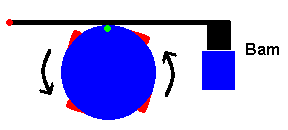
The Cam (animation)
Here is another place where you use the action of wedges - a simple ballpoint pen. I'll bet you have clicked these things your whole life, but never stopped to tear one apart to see how it works.
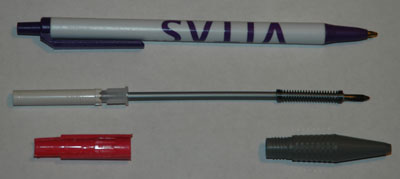
A simple spring is used to exert constant pressure on the part of the pen you click on. That piece simply rides up and down in channels grooved on the interior of the outside housing (red piece in image above) and sticks out the back of the pen. However, this piece is also in constant contact with a tiny plastic piece which is able to rotate inside the barrel. What produces rotation are many tiny wedges at the base of the piece you click on. When you click the pen and release it, the entire unit tries to retract, but can only go back as far as the stops in the outside housing will allow. These "stops" alternate between deep and shallow, allowing only two possible rest positions. At the same time, more tiny wedges in the outside housing rotate the plastic piece just enough so that it is in a position to cause further rotation the next time you click the pen. The wedges here are not designed to offer any mechanical advantage, but are used to dictate the direction of motion. Maybe the animation below will help you visualize the process of opening and closing your pen.

Look at all the wedges in action inside your pen. (animation)
Can you think of another place this idea can be utilized? (If not, I'll remind you later).
Another place you find an application of the wedge is a common zipper. One wedge forces the strips together (zipping up) and another pulls them apart (zipping down).

Zipper (animation)
The screw is nothing more than a wedge ... only applied in a circle (actually a helix ... like a spiral staircase).
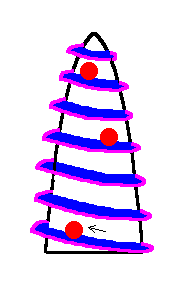
Suppose you had to get some heavy spheres (illustrated in red) to the top of this steep hill. The easiest way would be to construct a spiraled shaped ramp leading to the top ... then roll the spheres up the ramp. However, you can accomplish the same goal if you secure the red spheres to the track and spin the spiral structure. You would have just invented the screw. The ancient Greeks were well aware of the practical applications of the screw. The Archimedes Screw could lift water and screw conveyors were used to transport bulk feed.
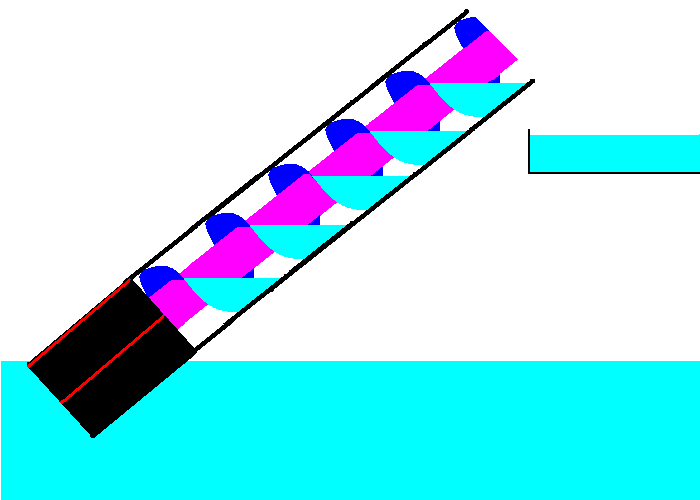
Archimedes Screw (animation)
You can find more applications of the screw in drill bits, augers, and worm gears. Windshield wipers use worm gears ... click link 1.5.a to see a neat demonstration.
A "worm gear" uses a screw to turn a gear.
Why not set a screw in a stationary (fixed) housing? When the screw is turned, the screw itself will move (acting like a wedge). In fact, it will be capable of producing great forces as a result. Hey, I also see levers being used in the pictures below.
A single pulley gives you no mechanical advantage (MA=1), but it does allow you to direct forces in a different direction. Things can get easier if you use a counter-weight. If the counter-weight matches the load ... all you have to do is overcome friction, making the lift easy. Most elevators have a counter-weight which is equal to the weight of the elevator plus 40% of its maximum load. To gain a mechanical advantage, however, multiple pulleys must be used in a system known as a "block and tackle".
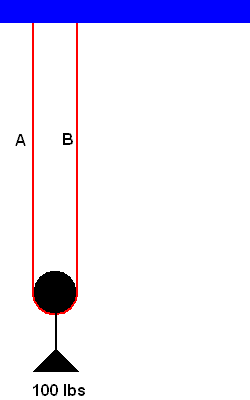
Movable pulleys give a mechanical advantage (animation)
|
|
|
|
First we need to convince you that "movable" pulleys provide a mechanical advantage. Consider the animation above. If a 100 pound weight is at rest and supported by 2 ropes, the force in each supporting rope must be 50 pounds. That is, the tension in ropes A and B equal 50 pounds. That situation does not change if a new "fixed" pulley is introduced (force in rope C is also 50 pounds). Now suppose you wish to lift the 100 pound weight (say 1 foot upward). This would require 100*1 = 100 foot pounds of work. In the absence of friction, a person would have to exert 50 pounds over a distance of 2 feet to balance the energy sheet. Again we see a trade off of force for distance.
When multiple pulleys are involved, the situation becomes more complicated, but there is a shortcut you can use. The mechanical advantage is equal to the number of ropes supporting the load (provided frictional forces are ignored).

The Block and Tackle (animation)
In this example the mechanical advantage is 4 because the load is supported by 4 ropes. This means 200 pounds of force would be required to lift an 800 pound load.
Gears and Belt systems
Your car is loaded with gears and belts. They are used to transfer power from one system to another, make something spin at the correct rate and/or proper direction, or with the proper torque. If you look under the hood of your car, you will notice lots of fan belts. They are useful if you have to transmit power over some physical distance. However, belts wear out and are subject to slippage. Your engine and automatic transmission are a maze of gears ... in fact, there are gears found along the entire power train of your car. Gears allow you to convert linear motion into rotational motion or vice versa (see the animation of the rack and pinion below).
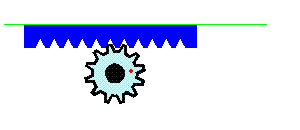
rack and pinion (animation)
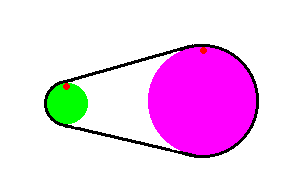
A simple belt animation (animation)
In the system of belts (above), suppose the smaller (green) hub is the input pulley (power in) and the larger (magenta) hub is the output pulley (power out). The smaller green hub is spinning very fast (high RPM) and can deliver a certain amount of torque. The larger magenta hub spins slower, but can deliver a higher torque. Something like this is usually found on systems that use electric motors or engines. The motor (or engine) spins very fast and can only produce so much torque. Speed reducers use systems of gears or belts to reduce the RPM's and increase the torque. In other words, belts and gears let you trade torque for speed (RPM) or vice versa. Examples can be found in electric screwdrivers, washing machines, automobile transmissions, etc.
Torque (in) * RPM (in) = Torque (out) * RPM (out)
or
Torque (in) * RPM (in) = Torque (out) * RPM (out)
The machines mentioned to this point were used throughout antiquity in one form or another. However, the hydraulic press did not come into existence until the late Renaissance. The study of incompressible liquids by Blaise Pascal (1623–1662) led to a device we call the hydraulic press. This device (a.k.a. the Bramah Press after the inventor, Joseph Bramah) provided a tremendous mechanical advantage. It is, therefore, used in many aspects of industry from heavy equipment to assembly lines. Pascal noted that the pressure a liquid exerts on the wall of a closed container is dependent on height (i.e. liquid pressure is slightly greater at the base of a vessel). Furthermore, if an external force is applied to the liquid, this extra force increases the pressure evenly throughout the liquid. That is, by increasing the pressure at one point by 50 psi (pounds per square inch) all points in the liquid will experience the same rise in pressure. If the external force is large enough, the small pressure difference due to height can be ignored, and we can think of the overall pressure as a constant.
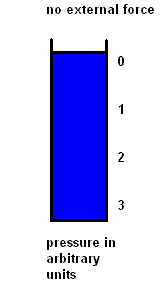
Pascal animation
This principle gives engineers an easy way to transmit large forces over large distances and even ways to gain a mechanical advantage in the process.
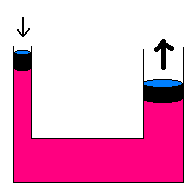
(animation)
Because liquids are incompressible, they easily allow the transmission of forces throughout the liquid. The smaller piston (on the left) moves down, compressing the liquid to high pressures. This is transmitted throughout the liquid, producing the outward motion of the larger piston (shown on the right). Since pressure is the force per area, a small force on the input (smaller) piston results in a much larger force at the output piston. Again the trade-off is that the input piston must travel a much greater distance than the distance traveled by the output piston.
For example, suppose the smaller piston has a cross section of 2 square inches and a 100 pound force is applied to it. This increases the pressure of the fluid by 50 psi (pounds per square inch). If the larger piston has a cross section of 20 square inches, the outward force becomes 20 * 50 = 1,000 pounds. This is a mechanical advantage of 10.
The hydraulic press is applied in car jacks, braking systems, power steering, and most industrial machinery (presses, garbage trucks, etc).
Another interesting application of hydraulics is seen in hydrostatic transmissions. A pump converts mechanical energy (from a rotating shaft) to a high pressure working fluid. At another location this fluid converts the energy of the compressed fluid back to rotation as it spins the blades of a hydraulic motor (or pushes a hydraulic cylinder). See some great animations at link 1.5.b or link 1.5.c. This is commonly seen on excavators, lawn tractors, and forklifts.
©2001, 2004, 2007, 2009, 2016 by Jim Mihal - All rights reserved
No portion may be distributed without the expressed written permission of the author